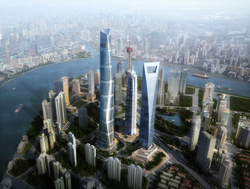Nov 30 2008
Groundbreaking ceremonies held today mark the start of construction on Shanghai Tower. The 632-meter building designed by Gensler, a leading global architectural design firm, advances sustainable design strategies and gives prominence to public spaces.

The Shanghai Tower Construction & Development Co., Ltd., is the project’s developer. Thornton Tomasetti structural engineers, Cosentini Associates mechanical, electrical and plumbing engineers and the Architectural Design and Research Institute of Tongji University as the Local Design Institute will support Gensler. The development is slated for completion in 2014.
Shanghai Tower is located in the Luijiazui Finance and Trade Zone, an area of Shanghai that was farmland eighteen years ago. The district is poised to become China’s first super-tall district, as Shanghai Tower rises to complete a trio of towers including the adjacent Jin Mao Tower and Shanghai World Financial Center (WFC). Together, these three will form a new icon on Shanghai’s skyline. While the design of the Jin Mao Tower pays homage to China’s past, and the WFC’s design signifies China’s recent economic growth, Shanghai Tower’s design is a beacon of China’s future.
“This tower is symbolic of a nation whose future is filled with limitless opportunities,” said Qingwei Kong, President of Shanghai Tower Construction & Development Co., Ltd. “With Shanghai Tower we celebrate not only China’s economic success and increasing connection to the global community, but also our company’s commitment to developing properties that demonstrate the highest, noblest and most exquisite design achievements possible.”
Shanghai Tower will house Class-A office space, retail, a luxury hotel and cultural venues. The uppermost floors will feature the world’s highest non-enclosed observation deck. The tower’s podium building will offer a high-end retail environment with a major event space. Below-grade facilities include retail, connections to the Shanghai Metro and three floors of parking.
“We hope Shanghai Tower inspires new ideas about what sustainable tall buildings can be,” said Art Gensler, FAIA, Chairman of Gensler. “We’ve lined the perimeter of the tower, top to bottom, with public spaces, and we’ve integrated strategic environmental thinking into every move. The tower is a stage that comes to life through the presence of people.”
Tower Composition
Shanghai Tower is organized as nine cylindrical buildings stacked one atop another. The inner layer of the double-skin façade encloses the stacked buildings, while a triangular exterior layer creates the second skin, or building envelope, which gently rotates as it rises. The spaces between the two façade layers create nine atrium sky gardens. Much like plazas and civic squares in traditional cities, the sky atria offer spaces within Shanghai Tower for interaction and community with restaurants, cafés, coffee shops and convenience stores, as well as lush landscaping.
With sky gardens lining the tower’s perimeter, Shanghai Tower is literally wrapped in public spaces. Both interior and exterior skins are transparent, establishing a visual connection between the tower’s interiors and Shanghai’s urban fabric. At night the building’s glowing translucent form further highlights interior public spaces. On the ground level, retail and event spaces, in tandem with abundant entrances on the site, further the physical and visual connections between the tower and the city.
Sustainable Strategies
In accordance with the goals of the Shanghai Tower Construction and Development Co., Ltd., the tower will be one of the most sustainable tall buildings in the world. Working closely with Thornton Tomasetti and Cosentini, Gensler adopted a fully integrated design approach, ensuring all design decisions uphold a sustainable intent.
The façade’s taper, texture and asymmetry work in partnership to reduce wind loads on the building by 24 percent, offering considerable savings overall in both building materials and construction costs. In addition, the building’s spiraling parapet collects rainwater, which is used for the tower’s heating and air conditioning systems. Wind turbines located directly beneath the parapet generate on-site power. The landscaped atria improve indoor air quality and create comfortable places for people to linger. Shanghai Tower’s owners aim to register for a high level of building certification from the China Green Building Committee and the U.S. Green Building Council.